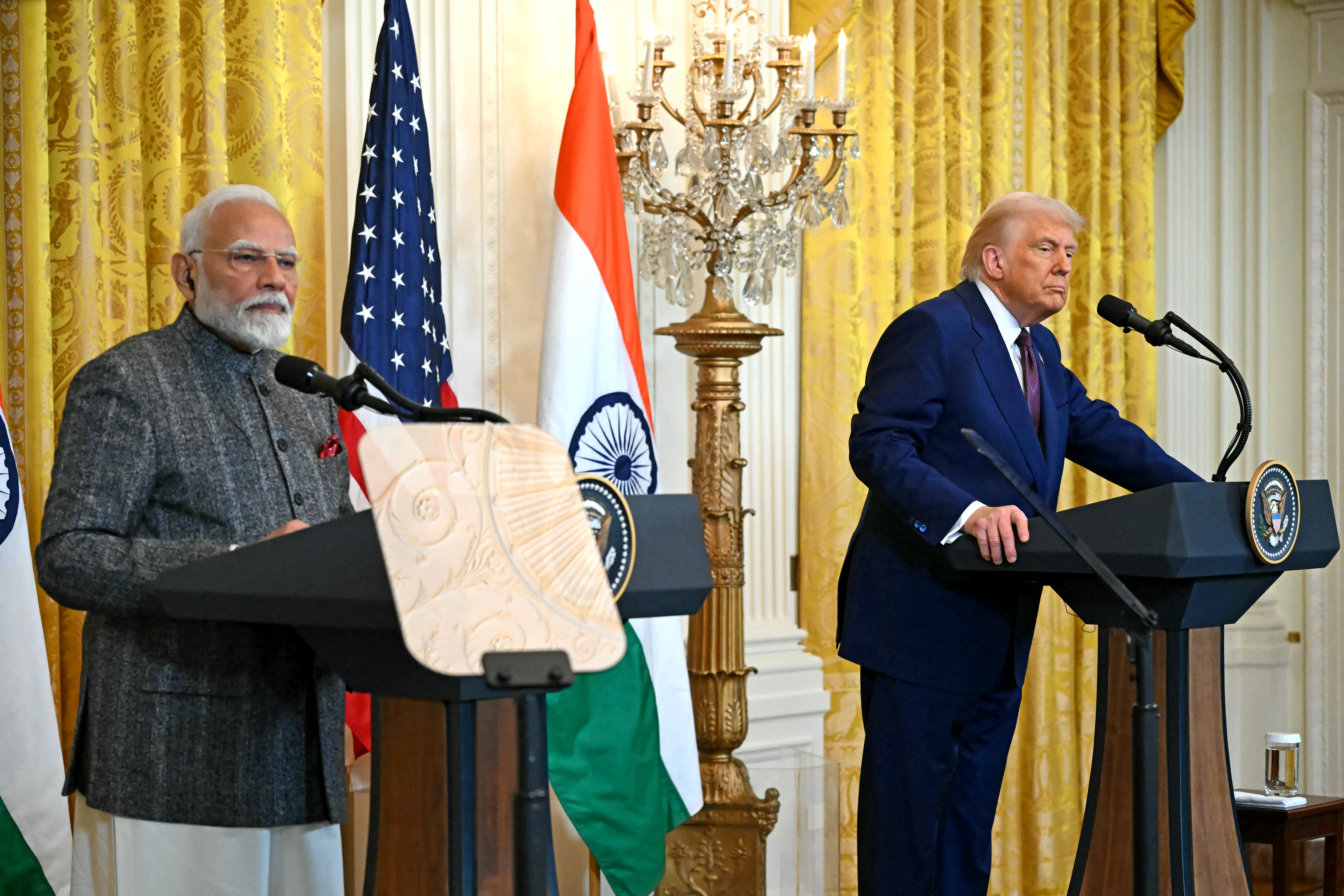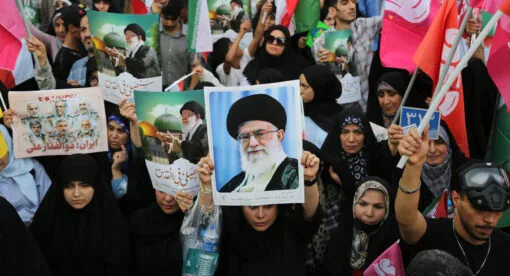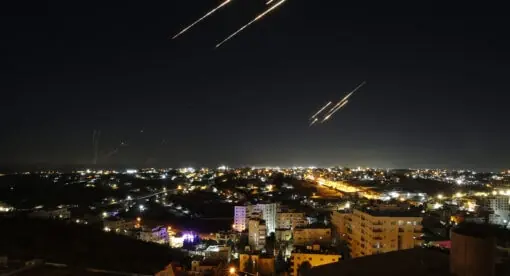Indian Prime Minister Narendra Modi’s first visit to Washington under President Donald Trump’s second administration came amid the escalating U.S.-Iran-Israel crisis. While Israeli Prime Minister Benjamin Netanyahu, who met with Trump ahead of Modi’s visit, fully supports the administration’s “maximum pressure” campaign on Iran, Modi faces a balancing act.
At stake is India’s growing strategic partnership with Israel – particularly in defense and technology – through arms deals, intelligence cooperation, and joint innovation, which has not only bolstered bilateral ties but also reinforced India’s broader strategic alignment with the United States. By deepening cooperation with Israel, India has positioned itself alongside Washington in countering China’s expanding footprint in the Middle East and endorsing a U.S.-led geoeconomic order in the region – one that aligns closely with Gulf Arab states like Saudi Arabia and the United Arab Emirates.
Despite these linkages, interdependencies, and shared strategic interests with Israel and the U.S., India cannot afford to sideline its relationship with Iran, which remains crucial for energy security and regional connectivity, and a counterweight to China’s Belt and Road Initiative (BRI).
A growing concern for Modi is a Trump administration executive order issued in February that sought to modify or revoke India’s sanctions waiver for the development of the Chabahar Port in southwestern Iran. This port is vital for India’s access to Afghanistan and Central Asia and serves as a strategic counterbalance to Pakistan’s Gwadar Port, which was developed with Chinese assistance. Trump’s executive order threatens not only Chabahar but also India-Iran collaboration on multiple fronts, including the modernization of the 4,660-mile International North-South Transport Corridor (INSTC), a multimodal trade route linking India, Iran, Azerbaijan, Russia, Central Asia, and Europe. Furthermore, it casts uncertainty over their cooperation in multilateral platforms such as the U.N., BRICS – in which Iran became a member in January 2024 – and the Shanghai Cooperation Organization (SCO), placing broader regional and economic partnerships at risk.
The India-Middle East-Europe Economic Corridor (IMEC), conceived during the G20 summit in New Delhi in December 2023, was envisioned as a strategic initiative to expand India’s economic footprint while balancing competing regional interests. However, Trump’s agenda puts the corridor’s viability increasingly in question, as renewed U.S.-Iran tensions complicate India’s diplomatic strategy and threaten its broader connectivity ambitions in the region.
While India and the U.S. align on the strategic importance of the IMEC – an understanding reinforced during Modi’s visit to Washington – their approaches toward Iran remain deeply contradictory. The IMEC – positioned as a U.S.-backed alternative to the BRI – was meant to solidify India’s role as a neutral economic bridge between South Asia, the Middle East, and Europe. However, with Trump’s agenda sparking a new diplomatic crisis and deepening U.S.-EU divisions over Ukraine, the strategic foundations of the IMEC are growing fragile. Likewise, growing instability in Gaza and likely intensified clashes between Israel and Iran-backed proxies in Lebanon, Syria, and Yemen – amid U.S. support for Israel – threaten to further weaken regional commitment to the corridor, putting its long-term success in jeopardy before it can fully take off.
Meanwhile, China’s growing financial leverage over Iran and the Gulf remains a counterforce to U.S.-led initiatives, adding another layer of geopolitical risk to the IMEC’s sustainability. China’s expanding economic influence in both Iran and among the Gulf Arab countries further complicates India’s strategic ambitions in the Middle East. While India envisions the IMEC as a counter to China’s Belt and Road Initiative, Beijing’s deepening financial and trade ties with both Iran and key GCC states like Saudi Arabia and the UAE pose significant challenges. China remains Iran’s largest trading partner, a key purchaser of its sanctioned oil, and a major investor in BRI-backed infrastructure projects, including the Yadavaran and North Azadegan oil fields and the Tehran-Mashhad High-Speed Rail project. Under its 25-year strategic partnership with Tehran, Beijing has committed up to $280 billion to Iran’s energy and transport sectors, further integrating Iran into China’s regional connectivity framework. Simultaneously, China’s extensive economic partnerships with GCC states – including multibillion-dollar energy deals and major infrastructure investments – limit the IMEC’s ability to gain a strategic edge. As a result, India must navigate an increasingly competitive landscape where China’s financial leverage over both its partners and regional rivals could weaken the IMEC’s long-term viability.
As Trump’s maximum pressure policy resurfaces, key IMEC stakeholders – including India, Saudi Arabia, the UAE, Israel, and major European players such as France, Germany, Greece, and Italy – face difficult choices. Further, ongoing Israel-GCC tensions, compounded by Trump’s hard-line position on Gaza – including the proposed U.S. takeover, development of the strip, and forced displacement of millions of Palestinians to neighboring countries like Egypt and Jordan – could jeopardize Israel’s normalization efforts with Saudi Arabia. These tensions also threaten regional economic agreements like I2U2 (India, Israel, the UAE, and the U.S.), risk fragmenting regional alignment, and ultimately weaken long-term commitment to the IMEC.
At the diplomatic level, India’s self-proclaimed leadership of the Global South is under scrutiny, as it remains one of the few BRICS and Global South nations that has not openly condemned Israel – a position that could complicate its engagement with key IMEC partners, particularly in the Middle East. As the IMEC’s long-term success depends on strong regional buy-in, this contradiction – championing the Global South while aligning with Israel and the U.S. – complicates India’s ability to sustain trust, not only in the Global South but also among the IMEC’s Arab partner countries, where public sentiment overwhelmingly supports Palestine. While the UAE has maintained economic cooperation with Israel, Saudi Arabia’s stalled normalization efforts amid regional backlash over the Gaza war highlight the political sensitivities at play. In this context, Modi’s increasingly pro-Israel diplomacy risks eroding India’s longstanding credibility as a neutral power, making long-term trust and cooperation within the IMEC more fragile if India is seen as prioritizing U.S.-Israel ties over broader Arab concerns.
As geopolitical tensions escalate in the Middle East, India’s ability to navigate its balancing act between Israel and Iran will determine whether the IMEC remains a viable economic initiative or succumbs to regional fragmentation as a result of Trump’s policies. With Trump reviving his maximum pressure policy, U.S.-Iran hostilities could strain regional cooperation, while heightened instability in Gaza and ongoing clashes involving Iran-backed groups in Lebanon, Syria, and Yemen add further uncertainty.
For India, IMEC’s success hinges not just on infrastructure investments but also on its ability to sustain trust among partners, particularly in the Gulf, without becoming entangled in regional rivalries. A rigid reliance on the corridor may prove insufficient in an increasingly multipolar order, where flexible, issue-based bilateral strategic partnerships with Israel, Iran, and key Gulf states – grounded in energy, technology, and trade – offer a more pragmatic alternative. India must carefully navigate its economic ambitions and strategic alignments, ensuring that the IMEC enhances – rather than constrains – its long-term diplomatic flexibility in the Middle East.
IMEC as a Pillar of India’s Middle East Strategy
The IMEC is a direct outcome of long-standing efforts to strengthen Middle East-South Asia connectivity, a shared priority for India and key regional powers. Building on the 2020 Abraham Accords and I2U2, the corridor was envisioned as a platform for economic integration while aligning with the strategic priorities of its stakeholders. Saudi Arabia’s expanding role in regional infrastructure and trade reinforced this vision, particularly as U.S.-led efforts to normalize ties between Saudi Arabia and Israel gained momentum. High-level diplomatic engagements in May 2023 formalized the IMEC, establishing a multilateral framework to enhance trade, infrastructure, and energy linkages across the Middle East, India, and Europe.
The IMEC’s eastern leg connects India’s west coast to the UAE via existing shipping routes, where goods are transported by rail through Saudi Arabia and Jordan to Israel’s Haifa port on the Mediterranean. The western leg then moves containers by sea to major European ports in France, Italy, and Germany, linking them to EU rail networks for final distribution. By integrating high-speed freight trains (about 75 mph, nearly four times faster than ships), the IMEC reduces reliance on the Suez Canal and cuts transit times by up to 40%, offering a faster, more efficient trade corridor between Asia, the Middle East, and Europe. Once fully operational, it is projected to bypass a route handling 30% of global container traffic and 12% of international trade, mitigating exposure to geopolitical disruptions.
The IMEC’s participating economies account for $47 trillion – nearly half of global GDP – making it a powerful trade and connectivity initiative. The corridor strengthens India’s economic ties with the EU ($136 billion in bilateral trade), the U.S. ($78.5 billion in exports in 2022-23), and GCC countries ($184 billion in fiscal year 2022-2023). The IMEC also aligns with Saudi Arabia and the UAE’s economic diversification strategies, positioning them as key transit hubs between Asia and Europe.
IMEC vs. BRI
While the BRI spans over 140 countries with investments exceeding $1 trillion, its reliance on Chinese state-backed loans has led to mounting debt burdens for recipient nations. Countries like Sri Lanka and several African economies have struggled with financial instability due to unsustainable debt obligations tied to BRI projects. In contrast, multilateral investments into the IMEC from the U.S., EU, India, and GCC ensure a more balanced economic initiative and reduce financial risks for participating countries.
Moreover, the BRI’s infrastructure investments, particularly in Iran and Pakistan, have strengthened China’s strategic influence in the Middle East, leveraging major energy and trade agreements. In 2022-2023, China-Iran trade amounted to approximately $15 billion, while China-GCC trade exceeded $285 billion, underscoring Beijing’s economic foothold in the region. The IMEC, in contrast, aligns Middle Eastern economies with Europe and South Asia, reducing dependency on China-controlled trade networks. The corridor also integrates sustainable infrastructure, including high-speed freight rail and renewable energy connectivity, providing a contrast to the BRI’s debt-driven model.
The IMEC enhances India’s already robust trade linkages with the GCC and Europe while reinforcing its strategic autonomy. Unlike the BRI, which remains largely China-centric, the IMEC promotes multipolar economic cooperation, offering a viable alternative for countries seeking infrastructure investments without long-term financial entanglements.
While the IMEC promises economic opportunities, its success is intertwined with the geopolitical realities of the Middle East. India’s growing defense and technology partnership with Israel, particularly under Modi’s administration, has reinforced its alignment with the U.S. and the corridor’s strategic vision. However, this alignment has also raised concerns, both regionally and domestically, as India seeks to balance its deepening ties with Israel while maintaining credibility with Arab states. Understanding how India’s pro-Israel tilt influences its positioning within the IMEC is crucial in assessing the corridor’s long-term viability and regional buy-in.
India and Israel
India’s deepening defense and technology ties with Israel have strengthened its strategic alignment with both Israel and the United States, positioning it more closely within a U.S.-led security and economic framework in the Middle East. This growing defense cooperation has translated into joint weapons development, intelligence-sharing, and high-tech defense systems, reinforcing India’s role in regional security partnerships that overlap with the IMEC’s broader strategic vision.
The IMEC is not just a trade corridor but also an initiative that supports the U.S.-backed regional security and connectivity framework, designed to stabilize key transit routes, safeguard critical supply chains, and counter China’s growing influence in the Middle East. By aligning with U.S.-Israel defense cooperation, India’s involvement in the IMEC extends beyond economic integration, embedding it within regional security frameworks that focus on maritime security, digital resilience, and energy infrastructure protection. Further, the corridor’s routes – traversing India, the UAE, Saudi Arabia, Jordan, Israel, and Europe – align with U.S.-led regional partnerships aimed at strengthening economic and strategic connectivity, reinforcing IMEC’s role as a pillar of Washington’s broader geoeconomic vision for the Middle East.
Since 2000, India has procured $4.2 billion worth of Israeli defense systems, making Israel one of its top three arms suppliers, alongside the United States and France. The collaboration has extended to jointly developed missile systems, unmanned aerial vehicles (UAVs), and AI-driven intelligence platforms, enhancing India’s maritime security in the Indian Ocean and border surveillance in the Himalayas. The Drishti-10 Starliner UAV, based on Israel’s Hermes-900 UAV, was co-developed with Adani Defense, reinforcing India’s surveillance capabilities and interoperability with Israeli defense technology. India’s adoption of Barak-1 and Spyder missile systems and its deepening partnerships with Israeli defense firms like IAI, Rafael, and Elbit Systems under the “Make in India” initiative have further cemented its military-technology linkages with the Israeli government. These security synergies with Israel align with India’s broader geoeconomic ambitions in the IMEC, particularly in maritime connectivity, digital security, and energy cooperation, positioning India alongside key U.S. allies in the region.
However, while India-Israel ties have strengthened India’s standing within Washington-led economic and security frameworks, they also introduce geopolitical risks within the IMEC. Saudi Arabia and the UAE – while maintaining their own trade and investment links with Israel – continue to vocally oppose Israeli actions in Gaza, reflecting widespread pro-Palestinian sentiment across the Arab world. India’s U.N. abstentions on cease-fire resolutions and reluctance to condemn Israeli military actions have been noted by Arab partners, raising questions about whether New Delhi can maintain its historical reputation as a neutral power in the Middle East. While these shifts have not immediately threatened the IMEC, they could erode long-term trust as regional players assess whether India’s growing alignment with Israel could undermine its credibility as an impartial actor within the corridor.
Domestically, Modi’s pro-Israel position has drawn criticism from India’s 200-million-strong Muslim population, as well as opposition parties that argue that New Delhi’s strategic tilt risks alienating its long-standing Palestinian solidarity. Regionally, the GCC and Arab League continue to advocate for Palestinian rights in international forums, adding pressure on India to balance its strategic partnerships without jeopardizing its wider economic and diplomatic engagements in the Middle East. The IMEC remains an economic project at its core, but its political dimensions cannot be ignored.
For India, success within the corridor will depend on its ability to maintain ties with Israel while sustaining trust among Gulf Arab partners on one side and Iran on the other, ensuring the IMEC’s vision of regional connectivity is not overshadowed by geopolitical friction.
India-Iran Relations and IMEC Challenges
India’s connectivity strategy has long relied on Iran as a key transit hub, particularly through the Chabahar Port and the INSTC, which links India to Afghanistan, Central Asia, and Russia. However, India’s IMEC ambitions face growing resistance from Iran’s deepening economic alignment with China under the BRI. The China-Iran 25-year strategic partnership signed in 2021 promises up to $400 billion in Chinese investments in Iran’s energy, transport, and industrial sectors. As China expands its footprint in Iran’s infrastructure, India’s influence is being gradually sidelined, making Iran less inclined to support alternative connectivity initiatives like the IMEC.
Additionally, China remains Iran’s largest trading partner, while despite efforts, India-Iran trade has sharply declined, falling from $17 billion in 2018-19 to just $2.3 billion in 2022-23, largely due to U.S. sanctions on Iranian oil. While India secured a 10-year agreement in May 2024 to develop the Chabahar Port, the project remains vulnerable to U.S. pressure and secondary sanctions. With the return of Trump’s maximum pressure policy, India could face further economic constraints, jeopardizing its long-term access to Chabahar as a critical transit point.
Beyond trade, China’s growing financial leverage among the GCC further weakens India’s position in the IMEC. Beijing’s long-term energy deals and major infrastructure investments in Saudi Arabia and the UAE, with bilateral trade in 2023 touching $107 billion and $94.98 billion respectively, comfortably outweigh India’s bilateral trade figures of $43.3 billion and $83.7 billion, respectively. This economic dominance makes it more difficult for India to position the IMEC as a viable alternative to the BRI, particularly when Iran views the latter as its primary pathway for regional integration.
India now faces the challenge of balancing its IMEC ambitions while maintaining diplomatic engagement with Iran, all while navigating U.S. sanctions and China’s entrenched economic influence in Tehran. Unlike the IMEC, which excludes Iran, the INSTC remains India’s only viable transit route through Iran, making it imperative for New Delhi to avoid alienating Tehran. Further, as shipping lines through the Red Sea face continuing risk of attacks by Yemeni al-Houthi rebels related to the ongoing Israel-Hamas conflict and the Suez Canal encounters recurring blockages, the INSTC provides an alternative route, less prone to disruptions.
Meanwhile, new tensions are escalating between Iran and the U.S., with Iranian Supreme Leader Ayatollah Ali Khamenei rejecting nuclear talks with the Trump administration, adding another layer of complexity to India’s calculations. The U.S. in February imposed fresh sanctions on Iran’s oil network, prompting Iranian President Masoud Pezeshkian to warn Washington of serious consequences on the eve of the 46th anniversary of the Iranian Revolution. As Trump issues new threats, Iran is preparing for a possible joint U.S.-Israel strike on its nuclear facilities, reinforcing its military posture by adding its first drone carrier to the Islamic Revolutionary Guard Corps fleet. In early March, China, Iran, and Russia conducted joint naval drills near the Gulf of Oman, a show of force amid U.S.-Iran tensions.
As U.S. allies and regional partners – including Jordan, Egypt, and GCC states – grapple with uncertainties surrounding Trump’s policy on Gaza and the rising potential for renewed hostilities between Israel and Iran and its proxies, India’s strategic choices are becoming increasingly difficult.
With IMEC’s success dependent on strong regional buy-in and sustained geopolitical stability, India must assess whether its current strategy can withstand the shifting fault lines of Middle Eastern geopolitics. The growing uncertainty over U.S.-Iran hostilities, China’s deepening role in the Gulf, and the unpredictable nature of Trump’s second-term policies raise critical questions about whether the IMEC can remain a sustainable pillar of India’s Middle East strategy. India will need to balance economic pragmatism with diplomatic flexibility, ensuring that its connectivity ambitions do not come at the cost of alienating key regional stakeholders or undermining its broader strategic autonomy.
Navigating Strategic Ambitions and Regional Realities
As India navigates an increasingly volatile Middle East, IMEC presents both a strategic opportunity and a formidable challenge. Positioned as India’s most ambitious connectivity initiative, the corridor offers a counterweight to China’s BRI while deepening economic and infrastructure ties with the GCC, Israel, and Europe. However, its long-term viability hinges on managing geopolitical fault lines, particularly as U.S.-Iran tensions escalate under Trump and China expands its economic influence across the region.
India’s balancing act between Israel and Iran remains crucial. While strengthening defense and technology ties with Israel has brought India closer to the U.S.-led regional order, it also introduces diplomatic sensitivities within the IMEC, given the pro-Palestinian sentiment across the Arab world. Meanwhile, Iran’s deeper integration into China’s BRI and renewed U.S. sanctions complicate India’s trade and connectivity ambitions, making its access to Chabahar and the INSTC increasingly uncertain. As geopolitical tensions rise, India must carefully manage these competing interests to protect its regional economic and strategic priorities.
For the IMEC to succeed, India must strategically recalibrate its diplomatic and economic approach. Rather than treating the IMEC as a singular geoeconomic initiative, New Delhi must adopt a flexible, issue-based strategy – deepening bilateral ties with Gulf Arab states, maintaining critical engagement with Iran through the INSTC, and ensuring its growing alignment with Israel does not erode confidence among key IMEC stakeholders. In a multipolar order in which economic pragmatism is as crucial as geopolitical positioning, India must leverage the IMEC as a vehicle for regional integration while insulating it from the volatility of great-power competition.
As Trump’s second-term policies, escalating U.S.-Iran hostilities, and shifting alliances redefine the Middle East, India’s ability to sustain trust among IMEC partners while safeguarding its strategic and economic interests will determine whether the corridor emerges as a transformative connectivity framework or collapses under geopolitical pressures. The stakes are high, and navigating this landscape will require both tactical agility and long-term vision.
Gopi Krishna Bhamidipati holds a Ph.D. from the Planning, Governance, and Globalization Program at Virginia Tech’s School of Public and International Affairs in Arlington, Virginia, where his research focused on India’s foreign policy toward Israel, Iran, and the Gulf Cooperation Council countries. Before pursuing his doctorate, he worked as a journalist in the United Arab Emirates and India, covering regional geopolitics and international affairs. Bhamidipati bridges journalism and policy research, with a strong focus on the Middle East, South Asia, and the Indo-Pacific. He delved into India’s West Asia policy and conceptualized Strategic Autonomy as a guiding foreign policy framework.
The views expressed in this article are those of the author and not an official policy or position of New Lines Institute.






